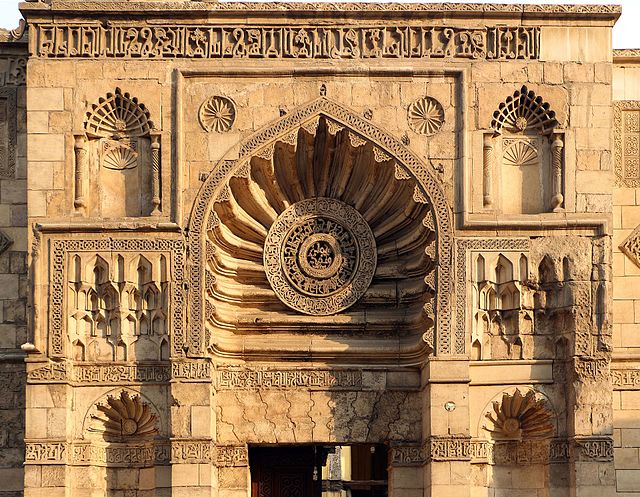The Aqmar Mosque, was built in Cairo, Egypt, as a neighborhood mosque by the Fatimid vizier al-Ma'mun al-Bata'ihi in 1125-6 CE. The mosque is situated on what was once the main avenue and ceremonial heart of Cairo, known today as al-Mu'izz Street, in the immediate neighborhood of the former Fatimid caliphal palaces. The mosque is an important monument of Fatimid architecture and of historic Cairo due to the exceptional decoration of its exterior façade and the innovative design of its floor plan.
Aqmar Mosque
The mosque in 1906, before modern restorations. (The right half of the facade was missing.)
Overall view of the mosque from the street
Renovated interior courtyard, looking towards the entrance and the minaret
Abu Abdallah Muhammad ibn Fatak, better known as al-Ma'mun al-Bata'ihi, was a senior official of the Fatimid Caliphate in the early 12th century, during the reign of al-Amir. His origin is obscure, but his father had held high military office, and thus al-Bata'ihi belonged to the Fatimid Egyptian elite. In 1107, at the age of about 21, he was chosen as chief of staff of the all-powerful vizier al-Afdal Shahanshah. In this capacity al-Bata'ihi carried out a number of tax reforms which raised revenue and ensured the payment of the military. Al-Afdal was assassinated in 1121, officially by Nizari agents of the Order of Assassins, although both Caliph al-Amir and al-Bata'ihi are suspected to have been involved by some sources. Al-Amir appointed al-Bata'ihi to the vacant vizierate, establishing a partnership between caliph and vizier that brought the former once again into the public view, while retaining for the latter the de facto governance of the state. As vizier, al-Bata'ihi was noted for his ability, justice, and generosity. He celebrated lavish festivals, where al-Amir had the opportunity to play a central role, and commissioned several buildings, of which the most important and only surviving one is the Aqmar Mosque in Cairo. Al-Bata'ihi also hunted down Nizari agents and sympathizers; the al-Hidaya al-Amiriyya, issued in 1122, rebuffed Nizari claims and affirmed the legitimacy of Musta'li Isma'ilism. During his tenure, the Fatimids became more directly involved in Yemen, often ignoring their Sulayhid ally, Queen Arwa. In the Levant, attempts to take the offensive against the Crusaders failed, with the loss of Tyre and a naval defeat at the hands of the Venetian Crusade. These failures, coupled with the caliph's resentment at al-Bata'ihi's power, led to his dismissal and imprisonment by al-Amir in 1125. He was then kept imprisoned until July 1128, when al-Amir ordered his execution. His son, Musa, wrote a biography that survives in fragments and is a key source for al-Bata'ihi's career.

Gold dinar of al-Amir, minted in Cairo in AH 514 (1119/20 CE)
Façade of the Aqmar Mosque, Cairo






